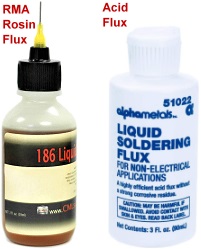|
If you do repair or restoration work on electronics assemblies with leaded components
(i.e., not surface mount), large metal mounting tabs, or other relatively high mass
surfaces to be soldered and the surfaces are contaminated and/or not easily tinned,
then the advice offered in this 1951 Radio & Television News magazine
article is well worth considering. Acid flux is normally taboo around electronics,
but, as author Herbert Brier points out, there are instances where, with careful
work, it can be used to create surfaces which can then be soldered using standard
rosin flux. The key is to use the acid flux sparingly and being sure to thoroughly
clean off the acid flux residue before moving on to rosin flux. I have done this
with both electronics and mechanical parts (such as music wire for model airplane
landing gear). I do NOT recommend ever using acid flux on insulated wire if the
flux can wick up under the insulation, and NOT on stranded wire since the flux will
get between the individual strands and can eat away at it over time. An exception
might be if the aforementioned wires are just being tinned and can be placed in
an ultrasonic cleaner with isopropyl alcohol or even a strong soapy water solution
to assure all traces of acid are removed.
Acid-Flux Solder
By Herbert S. Brier
Electronic technicians, who are sometimes tempted to circumvent Ohm's Law, would
rather eat oysters in July than to violate the command "Thou shalt not use acid-flux
solder." As with most laws, however, there are times when it can be safely ignored.
Consider the following:
You are servicing a receiver with, say, a defective filter condenser. Electrically,
the repair is simple, but mechanically it is a headache. The old condenser, apparently
the first part mounted, is riveted to chassis and completely surrounded by other
parts. There is no room to drill out or file the rivet without removing the obstructing
parts; therefore you bend the mounting strap back and forth until it breaks. Although
the old condenser is now out, the rivet is still there. After searching unsuccessfully
for another spot to put the replacement, you decide to solder the new mounting strap
to the chassis. Usually, the chassis is dirty and, with no room to work, it refuses
to tin. Of course, with patience, the job can be done at the cost of a few charred
parts and burned knuckles.
This is what happens with rosin-flux solder. But what a difference a little acid-flux
solder makes. The chassis tins easily and, after wiping with a bit of cloth to remove
any excess flux, you solder the mounting strap to it with regular rosin-flux solder.
Occasionally, a receiver comes in with a pulley, swedged to a control shaft,
loosened. Repair without damaging the control or other components generally requires
removing the assembly from the chassis. Probably every technician facing the problem
has tried soldering at least once. He usually discovers that either the shaft or
the pulley is impervious to rosin-flux solder. Acid flux makes child's play of the
job. Tin both parts with it and finish with rosin-core solder.
Rubber-covered "a.c. cord" sometimes solders with the greatest difficulty only
after meticulous scraping of each individual strand of wire. Tinning first with
acid-flux makes the task easier and usually results in a better job. Use it exceedingly
sparingly - just enough to tin the wire, wipe off immediately, and finish with rosin-flux
solder, applying heat long enough to cook out any residual acid. The last step is
especially important because, of the three samples given, it is the only one where
a little corrosion would do any important damage.
Other spots where acid-flux solder could be used to advantage have undoubtedly
come to your mind. The important thing to remember is that it is a special-purpose
tool. Used as above, it is invaluable, while, if used to solder something
like an i.f. or r.f. coil, it is almost certain to result in an open coil or a very
noisy receiver.
In my work, a single dime spool of acid-flux solder outlasts pounds of rosin-flux
solder, but it is always ready when needed.
Posted January 27, 2022
|





























